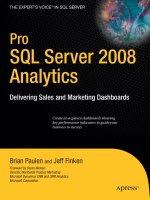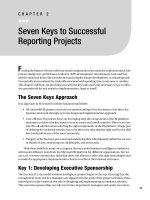Tài liệu Apress - Pro SQL Server 2008 Service Broker (2008)02 pdf
Bạn đang xem bản rút gọn của tài liệu. Xem và tải ngay bản đầy đủ của tài liệu tại đây (158.03 KB, 20 trang )
You can use SOA with other technologies, such as Service Broker. SOA defines the following
four core principles:
• Explicit service boundaries
• Autonomous services
• Explicit data contracts
• Interoperability
As you’ll see throughout this book, you can satisfy these principles better and with more reli-
ability with Service Broker. Explicit service boundaries mean that a SOA service must define a
service contract that exposes the operations available to other client applications. This is impor-
tant when a client uses discovery technologies to find an appropriate service on a network.
An autonomous service is one that a client can use to process a complete business
request. Email, for example, is an autonomous service, because a user request can be com-
pleted with one service interaction. If you want to send an email with an attachment, you can
do it in one step instead of two separate steps. The big challenge when you design your serv-
ices is to find the right granularity and make them as autonomous as possible.
In SOA, the contract defines the contents of the messages sent in both directions. In the
context of Service Broker, you can define the structure of the message body. You have no con-
trol over the structure of message headers. XML messages support interoperability, because
any computer system can exchange and process them.
SQL Server 2008 allows you to expose Service Broker services to other clients through
open standards, such as XML web services. This makes it possible for clients on other plat-
forms, such as Java, to interact with your Service Broker services. You can adhere to all four
SOA principles with Service Broker, making it an ideal platform for implementing SOA.
SODA
SQL Server 2005 offered at first a number of new features, including the following:
• Integration into .NET (SQLCLR)
• Query notifications
• Service Broker
• XML support
• Web services support
Many customers often ask why these features are now integrated directly into the data-
base. There are several good reasons for each feature that I won’t go into right now because
that’s not my purpose. My point is that you can only achieve real benefits from these features
when you use them in conjunction. The correct use of these features leads to SODA, the con-
cepts of which are explained in a white paper by David Campbell called “Service Oriented
Database Architectur
e: App Server-Lite?”
1
CHAPTER 1
■
FUNDAMENTALS OF MESSAGE-BASED PROCESSING 13
1. David Campbell, “Service Oriented Database Architecture: App Server-Lite?” Microsoft Research
(September 2005), />In SODA, you implement business functionality as SQLCLR stored procedures in the
database, and you use Service Broker as a reliable message bus to make your components
available to other clients. To publish services, you use native web services support in combi-
nation with the new XML features available since SQL Server 2005. When you look at this new
architecture, you can see that SQL Server 2008 is an important application server in such sce-
narios. Chapter 9 discusses implementing SODA applications with Service Broker.
Available Messaging Technologies
Service Broker is not the one and only messaging technology available for the Windows
platform. You can use several technologies to implement a message-based system, but Service
Broker offers some advantages over all the other messaging technologies described in this
section. For example, one important aspect of Service Broker is its distributed programming
paradigm. When you develop a Service Broker application dedicated for one SQL Server and
you later decide to spread the Service Broker application out to several physical SQL Servers
(maybe because of scalability problems), then you just have to configure your application to
support a distributed scenario. You don’t have to change the internal implementation details
of your Service Broker application.
Likewise, with load balancing, if you see in a later phase of your project that you must
support load balancing because of several thousands of concurrent users, you just have to
deploy your Service Broker application to an additional SQL Server and make some configura-
tion changes. Service Broker will handle the load-balancing mechanism for you in the
background. Chapter 11 talks more about these scenarios.
Despite these advantages of Service Broker, let’s now take a look at one of the most impor-
tant and familiar messaging technologies available today.
MSMQ
MSMQ has been available as part of Windows since the first version of Windows NT. MSMQ
was the first messaging technology from Microsoft used to provide messaging capabilities for
a wide range of business applications. One of the biggest advantages of MSMQ is that it is
licensed and distributed with Windows, so you don’t have any additional licensing costs when
you use it in your own applications. In addition, it’s not bound to any specific database prod-
uct. If you want to use Oracle with MSMQ, you can do it without any problems. However, as
with every product and technology, there are also some drawbacks, including the following:
• Message size is limited to 4MB.
• MSMQ is not installed by default. Furthermore, you need the Windows installation disk
to install MSMQ.
•Y
ou need distributed transactions if you want to run the message processing and
data-processing logic in one Atomic, Consistent, Isolated, and Durable (ACID)
tr
ansaction. This requires installation of the Microsoft Distributed Transaction
C
oordinator (MS DTC).
• Message ordering is not guaranteed.
• Message correlation is not supported out of the box.
CHAPTER 1
■
FUNDAMENTALS OF MESSAGE-BASED PROCESSING14
• You must implement queue readers manually.
• You must conduct synchronization and locking between several queue readers
manually.
• Backup and restoration can be a challenge, because message data and transactional
data are stored in different places.
Queued Components
Queued Components are a part of the Component Object Model (COM+) infrastructure.
With Queued Components, you have the possibility to enqueue a user request to a COM+
application and execute it asynchronously. Internally, a message is created and sent to a
dedicated MSMQ queue. On the server side, a component referred to as a Listener is used to
dequeue the message from the queue and make the needed method calls on the specified
COM+ object. For replay of these method calls, a component referred to as a Player is used.
Queued Components are attractive for a project that already uses the COM+ infrastructure
and requires doing some functions asynchronously and decoupled from client applications.
BizTalk Server
BizTalk Server is a business process management (BPM) server that enables companies to
automate, orchestrate, and optimize business processes. It includes powerful, familiar tools
to design, develop, deploy, and manage those processes successfully. BizTalk Server also
uses messaging technology for enterprise application integration (EAI). One drawback is its
licensing costs, which are very high if you need to support larger scenarios where scale-out is
an issue.
XML Web Services
XML web services is a messaging technology based on open standards such as SOAP and Web
Services Description Language (WSDL), and it’s suitable for interoperability scenarios. .NET
1.0 was the first technology from Microsoft that included full support for creating applications
based on web services technologies.
Over the past few years, Microsoft has made several improvements in the communication
stack and has made it even easier to design, implement, publish, and reuse web services.
WCF
The goal of
WCF, which was introduced with .NET 3.0, is to provide a unique application pro-
gramming interface (API) across all communication technologies currently available on
Windows. This includes the technologies already mentioned, as well as some others, such as
.NET Remoting. With a unique communication API, you can write distributed applications in
a communication-independent way. During deployment, an administrator can configure
which communication technology the application should use. Microsoft’s Service Broker team
might also include a WCF channel to Service Broker in an upcoming version of SQL Server, so
that you can talk with Service Broker applications directly from WCF-based applications.
CHAPTER 1
■
FUNDAMENTALS OF MESSAGE-BASED PROCESSING 15
Summary
In this first chapter, I provided an overview of the fundamentals of message-based program-
ming. I talked about the benefits of using messaging and how to achieve scalability for your
applications. I then discussed several problems that can occur when using messaging tech-
nology, and I showed you how Service Broker solves these problems so that you don’t need to
bother with them and can simply concentrate on the implementation details of your distrib-
uted applications.
I then described possible application architectures based on messaging architectures
such as SOA and SODA. Finally, I briefly described other messaging technologies available on
Windows and presented the pros and cons for each. With this information, you have all the
necessary knowledge for understanding the concepts behind Service Broker. In the next chap-
ter, I’ll introduce Service Broker itself.
CHAPTER 1
■
FUNDAMENTALS OF MESSAGE-BASED PROCESSING16
Introducing Service Broker
T
his chapter will describe the Service Broker architecture, including the following components:
• Conversations: In Service Broker programming, everything revolves around a conversa-
tion. I’ll explain exactly what a conversation is and what features it offers.
• Anatomy of a service: The core concept behind a Service Broker application is a service.
A service is composed of several elements, such as message types, contracts, a queue,
and a service program.
• Security: Service Broker is all about communication between services. It also provides
several security models that you can apply to your Service Broker application.
• Message processing: Service Broker exchanges messages between services. I’ll outline
the steps you need to successfully send a message from one service to another, and I’ll
explain reliable messaging.
• Performance: Service Broker provides different performance benefits, including the
transaction model and multiple queue readers.
Conversations
A conversation is a reliable, ordered exchange of messages between two Service Broker
services. The Service Broker architecture defines two kinds of conversations:
• Dialog: A dialog is a two-way conversation between exactly two Service Broker services.
Services exist on both the sending and receiving ends of a dialog. The one on the
sending side is referred to as the initiator service, and the one on the receiving side is
referred to as the target service. The initiator service starts a new dialog and sends the
first message to the target service. Both services can then exchange messages in either
direction.
• Monologue: A monologue is a one-way conversation between a single publisher
service and several subscriber services. This is a reliable version of the popular publish-
subscribe paradigm. Currently, monologues are not supported in Service Broker, but
they may be included in a future version of Service Broker.
17
CHAPTER 2
Dialogs
Dialogs are bidirectional conversations between two Service Broker services. Dialogs allow
Service Broker to provide exactly-once-in-order message delivery. Each dialog follows a
specific contract. A Service Broker dialog solves all the messaging problems discussed in
Chapter 1, in addition to the following features:
• Guaranteed delivery: Service Broker is a reliable messaging system. Therefore, the
sender of a message can be sure that the receiving side will receive the sent message
safely—even if the receiving side is currently offline.
• Long-lived: Dialogs can live for only a few seconds, but they can also span several years
for long-running business processes.
• Exactly once: Message delivery in Service Broker dialogs is guaranteed to occur exactly
once. If the initiator service must resend a message because the previous message
didn’t arrive at the sending side, then both messages will be received on the other side,
but only one message will be processed. The other duplicated message will be dropped
automatically from the receiving queue.
• In-order delivery: Service Broker ensures that messages are received in the same order
as they are sent from the initiator service. This addresses the message sequencing and
ordering problem discussed in Chapter 1.
• Persistence: A Service Broker dialog survives the restart of the whole database server,
because messages and dialogs are persisted directly in the database. This makes it easy
to perform maintenance on the database, because when you shut down the database
engine, all open dialogs and even unprocessed messages are persisted automatically
and become available as soon as you take the database engine online again.
Figure 2-1 illustrates a Service Broker dialog.
Figure 2-1. A Service Broker dialog
Dialog Lifetime
Applications can exchange messages during the lifetime of a dialog. The lifetime of a dialog
lasts from the time a dialog is created until another Service Broker service ends the dialog.
Each participant is responsible for explicitly ending the conversation when it receives a mes-
Service A
Database A
Service B
Dialog
Database B
CHAPTER 2
■
INTRODUCING SERVICE BROKER18
sage that indicates an error or the end of the conversation. In general, one participant is
responsible for indicating that the conversation is complete and successful by ending the
conversation without an error.
Dialogs can also guarantee that the lifetime of a conversation doesn’t exceed a specific
limit. The initiating service can optionally specify a maximum lifetime for the dialog. Both
services of a conversation keep track of this lifetime. When a dialog remains active at the
maximum lifetime, the Service Broker infrastructure places a time-out error message on the
service queue on each side of the conversation and refuses new messages for the dialog.
Conversations never live beyond the maximum lifetime that is established when a new
dialog begins.
Conversation Groups
A conversation group identifies one or more related conversations and allows a Service Broker
application to easily coordinate conversations involved in a specific business task. Every con-
versation belongs to one conversation group, and every conversation group is associated with
several conversations from different services. A conversation group can contain one or more
conversations.
When an application sends or receives a message, SQL Service locks the conversation
group to which the message belongs. This is called
conversation group locking. Thus, only one
session at a time can receive messages for the conversation group. Conversation group locking
guarantees that a Service Broker application can process messages on each conversation
exactly-once-in-order and keep state on a per-conversation group basis. Because a conversa-
tion group can contain more than one conversation, a Service Broker application can use
conversation groups to identify messages related to the same business task and process those
messages together.
This concept is important for business processes of long duration. For example, when you
order books online, the order-entry service sends messages to several other services and starts
a business process of reasonably long duration. The other called services could be any or all of
the following:
• Credit-card validation service
• Inventory service
• Accounting service
• Shipping service
Say the order-entry service starts four different dialogs to each of these individual serv-
ices. Service Broker groups these four dialogs together in a conversation group. These four
services may all respond at nearly the same time, so it’s possible that response messages for
the same order may be processed on different threads simultaneously without being aware
of each other. To solve this problem, Service Broker locks conversation groups—not conver-
sations. By default, a conversation group contains a single conversation—the conversation
started by the initiator service with the target service, the order-entry service. Figure 2-2
illustrates this concept.
CHAPTER 2
■
INTRODUCING SERVICE BROKER 19
Figure 2-2. Conversation groups
The tasks of the four background services that are started by the order-entry service are
normally done in the context of separate local SQL Server transactions. The message exchange
between the individual services takes place in the form of reliable messaging through the
Service Broker infrastructure. As soon as the order entry service receives replies from all of the
background services, it can reply with a response message back to the client and the business
process ends. When this event occurs, Service Broker closes the conversation group. Chapter 6
takes a detailed look at conversation groups and shows you how to achieve effective conversa-
tion group locking.
Message Sequencing
In Service Broker, message sequencing and ordering are ensured in the context of the
complete lifetime of a conversation. Sequencing and ordering are maintained through
sequence numbers, which are incremented for each sent message. If you send six messages,
each message gets a sequence number starting with 1. As soon as a message is sent from the
initiator service to the target service, Service Broker assigns the current sequence number
to the outgoing message. When the messages are dequeued on the receiving side, Service
Broker first tries to get the message with the sequence number 1, then the message with
the sequence number 2, and so on. When a message gets lost during the sending process,
the receiving side waits until the message is successfully resent—the receiving side can’t
skip a message that isn’t delivered successfully from the sender. The message retry send
period starts with four seconds and doubles up to 64 seconds. After this maximum of 64
seconds, the message is resent again once every 64 seconds—forever. Figure 2-3 illustrates
this process.
CreditCardService
Conversation
Group
InventoryService
AccountingService
ShippingService
OrderService
Client
CHAPTER 2
■
INTRODUCING SERVICE BROKER20









